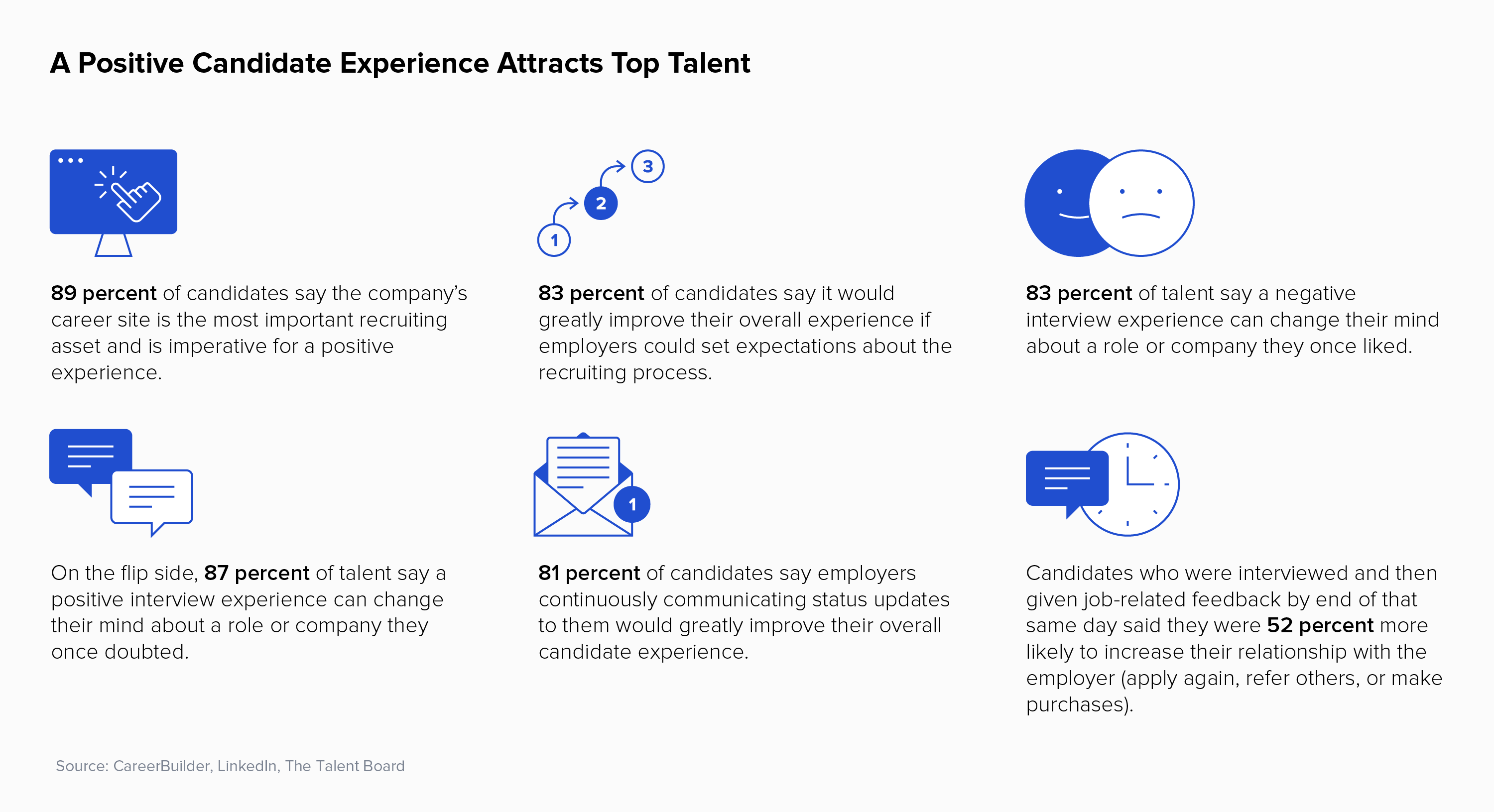If You Want to Hire the Best, Improve Your Candidate Experience
authors are vetted experts in their fields and write on topics in which they are extremely knowledgeable. All of our content is peer reviewed and validated by world-class professionals.

Recruiters, HR professionals, and hiring managers often struggle to find good candidates and keep them engaged throughout the interview and hiring process. Hiring is time-consuming; losing high-quality applicants or wasting time on candidates who are a poor fit can be a major setback for everyone involved.
To rectify this problem, organizations need to take a hard look at their candidate experience. A “candidate experience” encompasses all of the touchpoints that hiring managers have with a candidate throughout the sourcing, application, and hiring process. This experience creates a perception—either positive or negative—of both the job and the company. According to the 2019 North American Candidate Experience Research Report by Talent Board, a bad experience during the hiring process is the main reason candidates choose to withdraw.

Companies that struggle to connect with the right talent or see a high dropout rate in their hiring process need to conduct an in-depth audit of their candidate experience to determine why this is happening.
The Benefits of a Good Candidate Experience
On average, it takes 52 days and costs $4,000 to fill a position, according to Glassdoor. With a stronger pool of engaged candidates, screening and interviewing become easier and move more quickly, which reduces time-to-hire. In addition, a good candidate experience can create a talent pool of people who were not offered the advertised role but might be a good fit for a future role.
PointClickCare, a healthcare software company, reports that most of its current employees were hired on their second or third application and that 30% of their roles are filled through referrals, according to Talent Board’s candidate research. “It’s imperative to us that our candidates receive the best experience so that they can continue to reapply and refer their friends and family,” PointClickCare stated.
Candidates share positive recruiting experiences with their friends, family, and peers over 81% of the time. Positive experiences also prevent the reverse from happening: 72% of job seekers have shared bad experiences on Glassdoor and social media, and 27% of candidates have actively discouraged others from applying to a company.
A candidate-centric hiring process also boosts brand loyalty, especially for consumer companies. A bad candidate experience can have the opposite effect: Virgin Media famously discovered this the hard way. In 2014, Virgin executive Graeme Johnson realized that job applicants often canceled their Virgin Media subscriptions. When he dug deeper, he discovered that hiring managers were often impolite, late to interviews, and wrote unclear job descriptions that encouraged unqualified candidates to apply. In fact, that year, more than 130,000 people applied for jobs at Virgin Media, and more than 7,500 of those candidates canceled their subscriptions and switched to a competitor, costing the company $5.5 million.
Consumer goods company Kimberly-Clark, on the other hand, worked to create a positive experience for its candidates, even mailing coupons for its products to rejected candidates. When building the business case for an improved candidate experience, the company calculated that happy candidates represent a $300 million revenue stream.

How to Conduct a Candidate Experience Audit
To take a good look at your own candidate experience, it’s necessary to analyze the process at each touchpoint. Feedback can be collected from current candidates via surveys and interviews. Procter & Gamble uses a Net Promoter Score to capture reactions to their assessments. They also monitor dropout rates at each stage of the process to determine where changes need to be made.
When evaluating your candidate experience, look for specific issues at each stage of the process.
Sourcing: Can candidates easily find information about your company and the job?
Skilled talent shouldn’t have to look long or hard for an available position. Your candidate sourcing process should be part of a larger employer brand marketing strategy to attract strong people. First and foremost, your company career site should be up to date and easy to use. It should answer the most common questions for applicants and communicate your values and culture.
When Procter & Gamble evaluated its hiring process, it realized hiring managers were inundated with emails from candidates asking basic questions. Hiring managers weren’t able to reply quickly, and feedback from candidates showed this was a major source of frustration. The company implemented chatbots on its career site, which could immediately answer many of these questions. This saved the hiring managers time and allowed them to give more attention to job seekers that needed more significant help.
Applying: Is the application process clear and respectful of a candidate’s time?
A hiring process that respects a candidate’s time—by not canceling interviews at the last minute or not making candidates wait for long periods of time between communications, for example—results in a larger pool of high-quality candidates. This is important, because while hiring processes can take up to several months, most top talent is on the market for only 10 days.
Candidates typically spend between three and four hours preparing and submitting one job application, according to CareerArc’s State of the Candidate Experience report. Track your attrition rate at this stage. If a high percentage of candidates are dropping out, it’s possible the application is the problem. Sixty percent of job seekers quit in the middle of filling out online job applications because they are too long or too complicated. Take a hard look at the application. Are there redundant steps, such as uploading a resume and then asking the applicant to answer questions about education and previous job roles? Would someone with in-demand skills take the time to complete the application?
Communication at this stage is critical. Let candidates know you have received their application. Offer timelines for what to expect next, even if it’s a note saying you will not proceed with the process and thanking them for their time. The right technology can help here. Applicant tracking tools like Oracle Taleo, Jobvite, and Bullhorn can automate communication, maintain a record of all communication with each candidate in one place, and help keep in touch with strong candidates.
Interviews and Assessments: Do they offer an accurate representation of what it would be like to work at this company?
Prompt communication becomes even more important once the applicant has been invited to interview or complete an assessment. The interview and assessment process should be clearly outlined for the candidate, including a timeline, description of the assessments, and an estimate of the number and types of interviews. The candidate should also know to whom he or she can address questions.
Each interview should have a clear, distinct objective, to ensure that the candidate doesn’t have to repeat the same information multiple times. Interviews should also offer a sense of what it would be like to work at the company and should assess cultural fit. Your company is not the only one determining whether this is a match. Interviews are a good time to sell the candidate on the benefits of working for the company, including mission, values, and opportunities to learn new skills.
Offer feedback immediately after the interview and solicit feedback from the candidate about his or her experience at this stage. Was the process transparent? Did the interviews respect their time? Was communication clear and timely? When candidates are asked for feedback about the interview process, there’s a 148% increase in a positive candidate experience and willingness to increase the relationship with the organization, according to Talent Board.
Offers and Rejections: Are candidates notified promptly?
What is your offer acceptance rate? If it’s low, strong candidates may have accepted another offer before you had the chance to make one. A low acceptance rate might also indicate your process is not matching the right talent with the right job.
If the candidate is not a fit, inform them in a timely manner. Encourage strong candidates to apply for future positions and maintain contact through automated newsletters and emails as well as personal notes.
Treat Your Candidate Like a Customer
Companies that invest in a positive candidate experience will attract the right people, keep them engaged throughout the process, and ultimately hire people with the skills necessary to perform. Consider the entire process from the job seeker’s perspective, including their goals and expectations.
The candidate experience audit is not a one-time event, however. Hiring processes will continue to evolve as employers’ and candidates’ needs and expectations change. Performing an audit regularly—perhaps once a year—will help give your company a competitive advantage when selecting talent.
